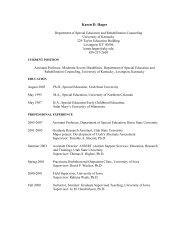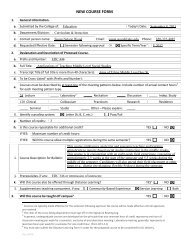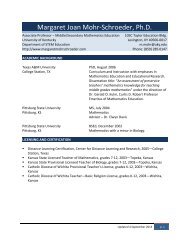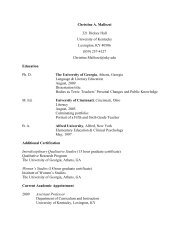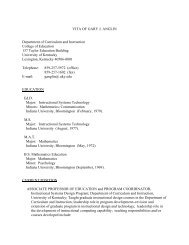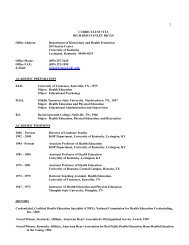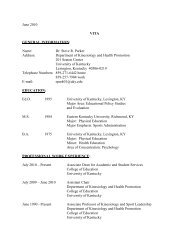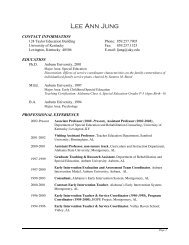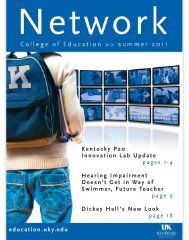Request for New Course (and Approval for Distance Learning)
Request for New Course (and Approval for Distance Learning)
Request for New Course (and Approval for Distance Learning)
Create successful ePaper yourself
Turn your PDF publications into a flip-book with our unique Google optimized e-Paper software.
REQUEST FOR NEW COURSEa model <strong>and</strong> tools <strong>for</strong> data analysis <strong>and</strong> team based discussions, reflection,decision making.<strong>and</strong>j: ~Prerequisites, if any: Nonek. Will this course also be offered through <strong>Distance</strong> <strong>Learning</strong>?I. Supplementary teach~ng coITlPonent, if any: 0 Community-Based Experience. - -- . . .....3. . Will this coursebe tau~htoffcampus?. 4. Frequency of <strong>Course</strong> Offering.YES 4 [Zl.0 Servi~~ Lear~ingNO 0o........... BothN() ~a. C.ours~\i\lill bi:!()~ft=rE!~(check~)lt~at afJply):b. Will the course be offered every year?o Spring······0 Sumtr,lerYES [ZlNO 0If NO, explain:..------.- ----.-.- .5. Are facilities <strong>and</strong> personnel necess~ry <strong>for</strong> the proposed new course available?If NO,explain:YE?BJ ..6. "Yhat enrollmentJper section per semester] may reasonably be expected? 15-20. 7. Anticip~ted S~LJdentl?~ma".~.a. Will this course servE!students primarily within the degree program?b. Will it be of interest to a sigflif.icant flumbi:!rof students outside thedegrE!E!pgl11?If YES,explain:.,. -H5619 may be taken by any graduate student interested in topic.8. Check the cate~ory most applicable to this course:YES [Zlx.~.?[8LNO 0N~D .o Relatively <strong>New</strong> - Now BeingWidelvEstablished[Zl Not Yet Found in Many (or Any) Other UniversitiesDTr~ditional- Offer,E!din Corresponding Departments at Universities Elsewhere9. <strong>Course</strong> Relationship to Program(s).a. Is this course p~rt of aproposed newpr()gr~rtl?If YES,name theproposedne\i\lprogram:b. Will this coursebe a new Eeguirement 5 <strong>for</strong> ANXprogram? ....I{YES S , list affectedprogr~ms:_ A ••MEd in Educational Leadership StudiesYES0YES~NoD10. In<strong>for</strong>mation to be Placed on Syllabus.a. Is the course 400G or 500? YES0 NO [Zl ......If YES,the differentiation <strong>for</strong> undergraduate <strong>and</strong> graduate students must be included in the in<strong>for</strong>mation required inlO.b. You must include: (i) identification of additional assignments by the graduate students; <strong>and</strong>/or (ii)establishment of differentgrading criteria in the course <strong>for</strong> graduate students.(See SR 3.1.4.)4 You must a/so submit the <strong>Distance</strong> <strong>Learning</strong> Form in order <strong>for</strong> the proposed course to be considered <strong>for</strong> DL delivery.5 In order to change a program, a program change <strong>for</strong>m must also be submitted.
REQUEST FOR NEW COURSEb.D The syllabus, including course description, student learning outcomes, <strong>and</strong> grading policies (<strong>and</strong> 400G-/500-level wading differentiation if applicable.from 10.0 above) are attached.
REQUEST FOR NEWCOURSEGeneral In<strong>for</strong>mation:Signature Routing Log<strong>Course</strong> Prefix <strong>and</strong> Number:El.~619Proposal Contact Person Name:Tricia Browne-FerrignoPhone: 257-5504Email: tricia.ferrigno@uky.eduINSTRUCTIONS:Identify the groups or individuals reviewing the proposal; note the date of approval; offer a contactperson <strong>for</strong> each entry; <strong>and</strong> obtain signature of person authorized to report approval.Internal College <strong>Approval</strong>s <strong>and</strong> <strong>Course</strong> Cross-listing <strong>Approval</strong>s:Reviewing Group Date Approved Contact Person (name/phone/email)EDL 11/10/09<strong>Course</strong>s & CurriculaCollege of EducationLars Bjork / 257-2450/Jf.~lR~f~e 7~~10~~~orAh 5'.fol\, Signature~ ~ ,!;;l41L1J~~'jeJf.(et5t~lAkyJr
ELS 619Evidence-Based Decision MakingUniversity of Kentucky College of EducationResearch <strong>and</strong> Reflection <strong>for</strong> <strong>Learning</strong> <strong>and</strong> Leading<strong>Course</strong> SyllabusXXX Semester, XXX YearSection XXX(1 credit hour)Hybrid <strong>Course</strong> DeliveryPredominately independent study supplemented withonline activities, fieldwork, <strong>and</strong> two class sessionsXXX (day) XXX (time) PMUK Campus Location TBAInstructor:Office:E-mail address:Contact In<strong>for</strong>mationKellie Terry, Ph.D.015 Dickey Hallkellie.terry@uky.eduOffice phone: (859) 257-2570Cell phone:Home phone:Office hours:Virtual office hours:Campus address:(517) 648-3727 (emergency only)(859) 577-1435 (no later than 9 PM)By appointment (preferably made via e-mail)TBADepartment phone: (859) 257-8921Department fax: (859) 257-1015Department of Educational Leadership Studies111 Dickey Hall, College of EducationUniversity of KentuckyLexington, KY 40506-0017Department Web site: http://education.uky.edu/EDL/ELS 619 Evidence-Based Decision Making Page 1
<strong>Course</strong> Description in UK BulletinELS 619 is the study of teacher roles <strong>and</strong> responsibilities when analyzing evidence of studentoutcomes at classroom <strong>and</strong> school levels <strong>and</strong> examination of a model <strong>and</strong> tools <strong>for</strong> data analysis<strong>and</strong> team based discussions, reflection, <strong>and</strong> decision making.Major <strong>Course</strong> ObjectivesThe purpose of this course is to exp<strong>and</strong> underst<strong>and</strong>ing of the roles <strong>and</strong> responsibilities of teacherleaders in evidence-based decision making in collaboration with other educators. The Data Wisemodel assists teacher leaders to engage in evidence-based instructional improvement processes.Upon completion of this course, students are expected to• Underst<strong>and</strong> roles <strong>and</strong> responsibilities <strong>for</strong> teacher leaders in evidence-based decision making;• Underst<strong>and</strong> how to build collaborative teams <strong>and</strong> use processes <strong>for</strong> evidence-baseddecision making;• Describe how to use assessments to collect <strong>and</strong> analyze in<strong>for</strong>mation on learning <strong>and</strong>teaching;• Describe ways to collaboratively examine <strong>and</strong> improve classroom practices;• Underst<strong>and</strong> how to develop, implement, <strong>and</strong> monitor action plans to improve studentlearning; <strong>and</strong>• Develop a professional action plan <strong>for</strong> evidence-based decision making.Required <strong>Course</strong> Textbooks <strong>and</strong> ReadingsProfessional reading <strong>and</strong> reflection are fundamental components of this course. The first booklisted below provides the major source of course content, while the second book is recommendedto assist students with their academic writing. Additional readings related to course content orprofessional development may be assigned throughout the course. Students are expected tocomplete all reading assignments each week in order to engage actively in online <strong>and</strong> classactivities.Boudett, K.P., City, E.A., & Murnane, R.J. (Eds.). (2005). Data wise: A step-by-stepguide to using assessment results to improve teaching <strong>and</strong> learning. Cambridge,MA: Harvard Education Press.American Psychological Association. (2009). Publication manual of the AmericanPsychological Association (6 th ed.). Washington, DC: Author.Required Instructional TechnologyThis course requires use of in<strong>for</strong>mation technology: Students are expected to have regular accessto a personal computer <strong>and</strong> the Internet to complete their learning activities. All Web-basedactivities are to be completed within designated sections of the course Blackboard, which can beaccessed through http://elearning.uky.edu.ELS 619 Evidence-Based Decision Making Page 2
Integration of Syllabus with UK College of Education Conceptual FrameworkThis graduate course addresses the four themes within the conceptual framework of the UKCollege of Education: research, reflection, learning, <strong>and</strong> leading. Throughout the semesterstudents have opportunities to review, analyze, discuss, <strong>and</strong> apply research from diverseperspectives in education, including professional scholarship <strong>and</strong> practitioner inquiry <strong>and</strong> reflecton their own practices as P-12 educators as they study, observe, <strong>and</strong> work in P-12 school <strong>and</strong>university classrooms. Reflection is integrated regularly through oral <strong>and</strong> written communicationto help students hone their analytical <strong>and</strong> problem-solving skills that comprise criticalprofessional reflection on one’s own practice. This course emphasizes the commitment of theUK College of Education to ensure that its graduates continue their professional careersequipped <strong>for</strong> life-long learning as educators actively leading colleagues in their schools,districts, <strong>and</strong> professional organizations. The ultimate goal in addressing these four themes is toproduce educational leaders who work together to improve student learning among diversepopulations <strong>and</strong> improve education in Kentucky <strong>and</strong> beyond.Commitment to DiversityUK is committed to making diversity central to university policies, decisions, <strong>and</strong> practices tostrengthen diversity within the Commonwealth. Ef<strong>for</strong>ts by a broad-based task <strong>for</strong>ce appointed byPresident Todd defined diversity asembracing difference or promoting increased knowledge regarding race/ethnicity, gender,religion, sexual orientation, disability, veteran affairs, <strong>and</strong> thought within an inclusivecommunity. This definition of diversity values an inclusive institutional culture, academicprograms, <strong>and</strong> co-curricular activities that prepare students <strong>for</strong> active, global citizenship.This commitment further allows <strong>for</strong> an educational process that fosters growth among allmembers of the academic community by including a wide array of talents, <strong>and</strong>recognizing the human differences are organizational strengths (University-WideComprehensive Diversity Plan Task Force Report, April 2005, p. 6).Because the desired outcome is excellence in education, UK “does not practice discrimination onthe basis of race/ethnicity, gender, religion, sexual orientation, or disability” (p. 6).The College of Education supports the university-wide definition of diversity <strong>and</strong> enhances itthrough an exp<strong>and</strong>ed interpretation. This broader conceptualization of diversity includes learningexceptionalities, native languages, socioeconomic status, <strong>and</strong> life experiences often created byresiding in unique geographical regions such as Appalachia. Curricula within the UK College ofEducation, field experiences, <strong>and</strong> membership of its faculty <strong>and</strong> student body reflect acommitment to diversity.Leading successful P-12 schools <strong>and</strong> districts requires underst<strong>and</strong>ing of <strong>and</strong> sensitivity todifferences among groups of people <strong>and</strong> individuals based on ethnicity, race, socioeconomicstatus, gender, exceptionalities, language, religion, sexual orientation, <strong>and</strong> geographical area.Hence, diversity is a theme woven throughout this graduate course, which focuses on preparing<strong>and</strong> developing principals <strong>and</strong> other educational leaders with requisite knowledge, dispositions,<strong>and</strong> skills to practice effectively the multiple responsibilities of school leadership <strong>and</strong> changeagency.ELS 619 Evidence-Based Decision Making Page 3
UK PoliciesThe adopted UK academic policies apply in this course <strong>and</strong> are articulated in the Students Rights<strong>and</strong> Responsibilities H<strong>and</strong>book <strong>and</strong> the UK Graduate Bulletin. Important policies <strong>and</strong> regulationsapplicable to this course include, but are not limited to, those concerning attendance, cheating<strong>and</strong> plagiarism, course withdrawal, incomplete grades, <strong>and</strong> acceptable st<strong>and</strong>ards of English. Asthe instructor, I retain absolute discretion concerning acceptance of required assignments afterestablished due dates <strong>and</strong> reserve the right to lower grades on assignments submitted late.Absences. The University defines acceptable reasons <strong>for</strong> absences as (a) serious illness,(b) university-related trips, (c) major religious holidays, <strong>and</strong> (d) other circumstances thatthe instructor finds to be “reasonable cause <strong>for</strong> nonattendance.” Because the class meetsonly five times, regular attendance is essential. If students must miss a scheduled classmeeting, then they must notify me about the reason <strong>for</strong> the absence be<strong>for</strong>e it occurs. Inthe event of emergency absences (e.g., personal illness, major accident, death of familymember), students should notify me as soon as possible, preferably through e-mailcommunication. Additional assignments may be required <strong>for</strong> missed class meetings.Canceled Class. If a class meeting must be canceled due to bad weather or otherun<strong>for</strong>eseen circumstances, I will make every possible ef<strong>for</strong>t to contact you in sufficienttime to avoid an unnecessary travel.Changes to Syllabus. I retain the right to modify this syllabus, if necessary, to meet thelearning objectives of this course. Changes to this syllabus will be discussed with you <strong>and</strong>provided in writing as an addendum distributed electronically via e-mail <strong>and</strong> posted onthe course Blackboard.Go to www.research.uky.edu/gs/bulletin/bullinfo.shtml <strong>for</strong> more in<strong>for</strong>mation about UK Policies.<strong>Distance</strong> <strong>Learning</strong> ConsiderationsThis course requires use of in<strong>for</strong>mation technology: Students are expected to have regular accessto a personal computer <strong>and</strong> the Internet to complete their learning activities. All Web-basedactivities are to be completed within designated sections of the course Blackboard, which can beaccessed through http://elearning.uky.edu.Teaching <strong>and</strong> Academic Support Services. Contact the UK Teaching <strong>and</strong> AcademicSupport Center <strong>for</strong> assistance via the Web (http://www.uky.edu/TASC/) or via telephone(859-257-8272).Procedures <strong>for</strong> Resolving Technological Problems. Contact the UK In<strong>for</strong>mationTechnology Customer Service Center via the Web (http://uky.edu/UKIT) or telephone(859-257-1300).In<strong>for</strong>mation on <strong>Distance</strong> <strong>Learning</strong> Library Services: The UK Library provides support<strong>for</strong> distance-learning students via the Web (www.uky.edu/Libraries/DLLS). You mayalso contact the DL Librarian, Carla Cantagallo, directly via electronic mail(dlservice@email.uky.edu) or telephone (859-257-0500 x 2171 or 800-828-0439).ELS 619 Evidence-Based Decision Making Page 4
Document Delivery <strong>and</strong> Interlibrary Loan Services. Contact the UK Library to requestbook not at UK via http://www.uky.edu/Libraries/libpage.php?lweb_id=253&llib_id=16.Students with a Documented Disability. The UK Disability Resource Center(http://www.uky.edu/StudentAffairs/DisabilityResourceCenter/) provides support <strong>for</strong>those needing accommodations. Contact Jacob Karnes, Jr., Associate Dean of Students<strong>and</strong> Director of the Disability Resource Center, via e-mail (jkarnes@email.uky.edu) ortelephone (859-257-2754) if you have a documented disability that requires academicaccommodations in this course. The Center will require current disability documentation.When accommodations are approved, the Center will provide me a letter that details therecommended accommodations <strong>for</strong> you.Maximum Timeframe <strong>for</strong> Responding to Student Communications. Electronic mailaddressed to kellie.terry@uky.edu is the best method <strong>for</strong> communicating with me. I shallmake every ef<strong>for</strong>t to respond to electronic mail messages within 48 hours excludingweekends or holidays or when the automatic reply is an out-of-office message. In case ofemergency, please call my office (859-257-2570) or the EDL office (859-257-8921).Collaboration with School PartnersIn accordance with requirements <strong>for</strong>m the Kentucky Education Professional St<strong>and</strong>ards Board(EPSB) to include partners, input from the Central Kentucky Educational Cooperative (CKEC),Fayette County Public Schools (FCPS) <strong>and</strong> the Southern Association of Colleges <strong>and</strong> Schools(SACS) personnel are involved in the design <strong>and</strong> delivery of this course.St<strong>and</strong>ards-based CurriculumELS 619 is an elective course <strong>for</strong> the MEd in Educational Leadership Studies designed to meet therequirements established by the Kentucky Educational Professional St<strong>and</strong>ards Board (EPSB). Thus,course content is based on the Interstate School Leaders Licensure Consortium (ISLLC) St<strong>and</strong>ards <strong>for</strong>School Leaders adopted by Kentucky in 1998 <strong>and</strong> updated in 2008. 1 Although ELS 604 focusesspecifically on evidence-based decision making, the four central, recurring themes within the originalst<strong>and</strong>ards provide a framework <strong>for</strong> teacher leadership including:• A Vision <strong>for</strong> Success• A Focus on Teaching <strong>and</strong> <strong>Learning</strong>• An Involvement of all Stakeholders• Demonstration of Ethical Behavior (Hessel & Holloway, 2002, p. 21) 2 .This course is also structured to align with these other professional st<strong>and</strong>ards:The advanced-level per<strong>for</strong>mance Kentucky Teacher St<strong>and</strong>ards (KTS) are integrated into content,assignments, <strong>and</strong> assessments as noted in Regulation 16 KAR 5:0101 Section 12 <strong>and</strong> the master’sredesign guidelines as adopted by the EPSB in 2007. The complete list of st<strong>and</strong>ards <strong>and</strong> indicators areavailable at http://www.kyepsb.net/teacherprep/st<strong>and</strong>ards.asp. ELS 619 addresses the following specificKentucky Teacher St<strong>and</strong>ards: KTS 1 Apply Content Knowledge; KTS 2 Design/Plan Instruction; KTS 31 Council of Chief State School Officers. (2008). Educational Leadership Policy St<strong>and</strong>ards: ISLLC 2008.Washington, DC: Author. Available at http://www.ccsso.org/publications/details.cfm?PublicationID=3652 Hessel, K. & Holloway, J. (2002). A framework <strong>for</strong> school leaders: Linking the ISLLC St<strong>and</strong>ards to practice.Princeton, NJ: Educational Testing Service.ELS 619 Evidence-Based Decision Making Page 5
Create/Maintain <strong>Learning</strong> Climate, KTS 4 Implement/Manage Instruction, KTS 5 Assess/Communicate<strong>Learning</strong> Progress; KTS 6 Implement Technology; KTS 7 Reflect/Evaluate Teaching <strong>and</strong> <strong>Learning</strong>; KTS8 Collaborate Others; KTS 9 Evaluate Teaching/Implement Professional Development; <strong>and</strong> KTS 10Provide Leadership.The Kentucky Education Professional St<strong>and</strong>ards Board adopted the Interdisciplinary Early ChildhoodEducation (IECE) <strong>New</strong> Teacher St<strong>and</strong>ards <strong>for</strong> Preparation <strong>and</strong> Certification: Interdisciplinary EarlyChildhood Education Birth to Primary <strong>and</strong> now requires use of the 2003 revised version. The IECEst<strong>and</strong>ards are closely aligned with KTS <strong>and</strong> integrated as appropriate into ELS 619 content, assignments,<strong>and</strong> assessments. A copy of the revised st<strong>and</strong>ards is available athttp://www.kyepsb.net/teacherprep/iecest<strong>and</strong>ards.aspThe International Society <strong>for</strong> Technology in Education (ISTE) has developed as set of st<strong>and</strong>ards <strong>and</strong>per<strong>for</strong>mance indicators <strong>for</strong> administrators, teachers <strong>and</strong> students 3 . <strong>Course</strong>s in the MEd in EducationalLeadership Studies, however, focus specifically those <strong>for</strong> administrators as a means to in<strong>for</strong>m <strong>and</strong> guideteachers when collaborating with their peers <strong>and</strong> principals to assure school-wide student learning. TheNational Educational Technology St<strong>and</strong>ards <strong>for</strong> Administrators (NETS·A) are available athttp://www.iste.org/Content/NavigationMenu/NETS/ForAdministrators/2009St<strong>and</strong>ards/NETS-A_2009.pdfQuality of Student WorkUnless specified otherwise, all papers submitted to me must be presented in the writing style <strong>and</strong><strong>for</strong>mat described in the sixth edition of the Publication Manual of the American PsychologicalAssociation 4 . All papers must be word-processed in Times <strong>New</strong> Roman 12-point font. Studentsare expected to follow rules of usage <strong>and</strong> principles of composition 5 . When the two resourceslisted in the footnote below present differing rules, students are to adhere to the academic writingguidelines in the APA Manual.Plagiarism. Where appropriate, references to professional <strong>and</strong> research literature need tobe integrated into the text <strong>and</strong> cited at the end of all papers. According to UK rules, theminimum consequence <strong>for</strong> cheating or plagiarism is an “E” in the course. Cheating orplagiarism is basically stealing ideas or intellectual property created by others. Studentsare cautioned to reference all resources properly: The mere re-phrasing of anotherauthor’s work does not excuse the student from the requirement <strong>for</strong> including propercitations. Cite all your sources accurately <strong>and</strong> appropriately! Be aware that re-cycling ofassignments from other courses can be interpreted as self-plagiarizing <strong>and</strong> fails to meetthe minimal st<strong>and</strong>ards of intellectual rigor required in graduate study.Late Submittals. Assignment due dates are provided in the course calendar (p. 9). Unlessspecified differently in the assignment guidelines, each written assignment is to bedelivered me as an attachment to an e-mail message addressed to kellie.terry@uky.edu<strong>and</strong> sent no later than 10:00 AM on the due date. Late assignments will be accepted onlyin cases of extreme emergencies, <strong>and</strong> the decision to accept late work is solely at mydiscretion.3 http://www.iste.org/AM/Template.cfm?Section=NETS4American Psychological Association. (2009). Publication manual of the American Psychological Association(6th ed.). Washington, DC: Author.5 Strunk, W., Jr., & White, E. B. (2000). The elements of style (4th ed.). <strong>New</strong> York: Longman.ELS 619 Evidence-Based Decision Making Page 6
Incomplete Grade. Incomplete grades <strong>for</strong> this course are issued reluctantly <strong>and</strong>sparingly. The UK Graduate School permits students one calendar year—unless ashorter time frame is determined mutually by the student <strong>and</strong> instructor—to removean “I” grade. If the contracted work is not completed satisfactorily, the “I” grade convertsautomatically to an “E” (a failing mark). UK <strong>and</strong> EDL rules require students requestingan “I” grade to complete a contract specifying how <strong>and</strong> when the “I” will be removedwithin the calendar year. The contract must be submitted to me be<strong>for</strong>e an “I” grade canbe issued. Incomplete work <strong>and</strong> missing assignments will be assigned “E” grades if thestudent does not submit a completed Incomplete Grade Contract by the course deadline.Student ResponsibilitiesGraduate students assume major responsibility <strong>for</strong> their own learning. As members of a learninggroup, they are likewise responsible <strong>for</strong> helping their peers by consulting with them <strong>and</strong>engaging in collaborative problem solving be<strong>for</strong>e seeking assistance from me. A class roster willbe posted in the course Blackboard site to encourage <strong>and</strong> support communication.<strong>Course</strong> Requirements <strong>and</strong> ExpectationsUnless specified otherwise, all assignments must be submitted to me electronically as anattachment to an e-mail message or posted on Blackboard no later than 10:00 AM on the duedate. Guidelines <strong>for</strong> course assignments will be posted on the course Blackboard.1. Professional Reflections. Students will respond to questions posed by me in Blackboard<strong>and</strong> engage in asynchronous dialogue with their class peers. To receive credit, studentsmust respond by the due dates appearing in the course calendar (p. 7) or published in theassignment guideline posted in Blackboard.2. Class Participation. Students are expected to attend the two class meetings, activelyparticipate in discussions <strong>and</strong> activities, <strong>and</strong> complete independent work as presented onthe course calendar.3. Critical Reflection. Students will write a 3-4 pp. essay, describing what they havelearned about evidence-based decision making through course readings, discussions,professional reflections. This reflective essay will prepare students <strong>for</strong> working on theirProfessional Action Plan, outlined in the next section.4. Professional Action Plan <strong>for</strong> Evidence-based Decision Making. Students will developa 5-7 pp. professional action plan, describing how they will apply concepts of evidencebaseddecision making in their work over the next two to three years. This plan shouldaddress major course objectives <strong>and</strong> topics outlined in the syllabus, describing howstudents will work with other educators to improve student learning through evidencebaseddecision making processes. The plan should also incorporate a self-assessment ofstudent strengths <strong>for</strong> engaging in identified processes, <strong>and</strong> describe how students willcontinue to increase their professional capacity in areas of need through additionalcoursework, professional development, <strong>and</strong> self-directed learning.ELS 619 Evidence-Based Decision Making Page 7
Grading Scale<strong>Course</strong> grades are based on a cumulative point total. The relative weighting <strong>for</strong> each of theseexpectations is presented in the matrix below.Class Assignments/ExpectationsPoints Possible1. Professional Reflections 202. Class Participation 103. Critical Reflection 304. Professional Action Plan <strong>for</strong> Evidence-based Decision40MakingTotal Points 100Grades will be assigned according to the following scale: A=90-100 points, B=80-89 points,C=70-79 points, E=
<strong>Course</strong> CalendarWeek Topic Reading Assignments ProductsDueOrganizing <strong>for</strong> Collaborative WorkBCM: Intro & Ch. 11 • Data Wise improvement process(class) • Creating a data team• Assessing organizational structures &initiatives• Collaborative processes <strong>for</strong> evidence-baseddecision makingBuilding Assessment LiteracyBCM: Ch. 22 • Types of assessments• Principles <strong>for</strong> interpreting assessment results• Measuring improvement• Strategies <strong>for</strong> interpreting dataData Overviews & Interpreting Student Data BCM: Ch. 3-43 • Organizing assessment data• Single data sources• Triangulating data sources• Per<strong>for</strong>mance trends• Leading data discussions45(class)• Identifying learner-centered problemsExamining Practice & Developing Action Plans• Linking learning <strong>and</strong> teaching• Factors in examining practice• Shared underst<strong>and</strong>ing of effective practice• Analyzing practice• Problem-solving in action• Implementing action plansPlanning to Assess Progress/Act & Assess• Choosing assessments• Setting goals• Collaborative action• Monitoring implementation• Support <strong>and</strong> accountability• Professional development <strong>and</strong> ongoing needs• Evaluating student outcomes <strong>and</strong> makingadjustments to the planAdditional ResourcesBCM: Ch. 5-6BCM: Ch. 7-8CriticalReflectionProfessionalAction Plan <strong>for</strong>Evidence-basedDecision MakingBernhardt, V.L. (2002). The school portfolio toolkit: A planning, implementation, <strong>and</strong> evaluationguide <strong>for</strong> continuous school improvement. Larchmont, NY: Eye on Education.Boudett, K.P., & Steele, J.L. (Eds.). (2007). Data wise in action: Stories of schools using datato improve teaching. Cambridge, MA: Harvard Education Press.Holcomb, E.L. (2004). Getting excited about data: Combining people, passion, <strong>and</strong> proof tomaximize student achievement (2 nd ed.). Thous<strong>and</strong> Oaks, CA: Corwin Press.Popham, W.J. (2002). Classroom assessment: What teachers need to know (3 rd ed.). Boston:Allyn & Bacon.Reeves, D.B. (2004). Accountability <strong>for</strong> learning: How teachers <strong>and</strong> school leaders can takecharge. Alex<strong>and</strong>ria, VA: Association <strong>for</strong> Supervision <strong>and</strong> Curriculum Development.Schmoker, M. (2003). First things first: Demystifying data analysis. Educational Leadership60(5), 22-24.ELS 619 Evidence-Based Decision Making Page 9
<strong>Distance</strong> <strong>Learning</strong> FormThis <strong>for</strong>m must accompany every submission of a new/change course <strong>for</strong>m that requests distance learning delivery. This <strong>for</strong>mmay be required when changing a course already approved <strong>for</strong> DL delivery. All fields are required!Introduction/Definition: For the purposes of the Commission on Colleges Southern Association ofColleges <strong>and</strong> Schools accreditation review, distance learning is defined as a <strong>for</strong>mal educational processin which the majority of the instruction (interaction between students <strong>and</strong> instructors <strong>and</strong> amongstudents) in a course occurs when students <strong>and</strong> instructors are not in the same place. Instruction may besynchronous or asynchronous. A distance learning (DL) course may employ correspondence study, oraudio, video, or computer technologies.A number of specific requirements are listed <strong>for</strong> DL courses. The department proposing the change indelivery method is responsible <strong>for</strong> ensuring that the requirements below are satisfied at the individualcourse level. It is the responsibility of the instructor to have read <strong>and</strong> understood the university-levelassurances regarding an equivalent experience <strong>for</strong> students utilizing DL (available athttp://www.uky.edu/USC/<strong>New</strong>/<strong>for</strong>ms.htm).<strong>Course</strong> Number <strong>and</strong> Prefix: ElS 619 Date: November 17, 2009Instructor Name: Kendall (Kellie) Terry Instructor Email: kellie.terry@uky.eduCheck the method below that best reflects how the majority of course of the course content will be delivered.Internet/Web-based D Interactive Video D Hybrid IZlCurriculum <strong>and</strong> Instruction1. How does this course provide <strong>for</strong> timely <strong>and</strong> appropriate interaction between students <strong>and</strong> faculty <strong>and</strong> amongstudents? Does the course syllabus con<strong>for</strong>m to University Senate Syllabus Guidelines, specifically the <strong>Distance</strong><strong>Learning</strong> Considerations?ELS 619: Evidence-Based Decision Making(see attached syllabus), con<strong>for</strong>ms to all University of Kentucky<strong>Distance</strong> <strong>Learning</strong> Syllabus Guidleines <strong>and</strong> specifically includes in<strong>for</strong>mation about virtual office hours,procedures <strong>for</strong> resolving technical issues, notification <strong>and</strong> in<strong>for</strong>mation about self-disclosure <strong>and</strong> procedures <strong>for</strong>disability accommodations etc.Web-based (Blackboard, Bb ) course delivery methods will be used <strong>for</strong> 60% of individual student engagement<strong>and</strong> course interactions (i.e.) 3 Bb <strong>and</strong> 2 Face-to-face seminars. Blackboard assignments described in thesyllabus include: (1) Professional Reflections: Students will respond to questions posed by the instructor inBlackboard <strong>and</strong> engage in asynchronous dialogue with their class peers; (2) Class Participation: Students areexpected to attend the two class meetings, actively participateindependent work as presented on the course calendar; (3) Critical Reflection:in discussions <strong>and</strong> activities, <strong>and</strong> completeStudents will write a 3-4 pp.essay, describing what they have learned about evidence-based decision making through course readings,discussions, professional reflections. This reflective essay will prepare students <strong>for</strong> working on theirProfessional Action Plan, outlined in the next section; <strong>and</strong> (4) Professional Action Plan <strong>for</strong> Evidence-basedDecision Making: Students will develop a 5-7 pp. professional action plan, describing how they will applyconcepts of evidence-based decision making in their work over the next two to three years. This plan shouldaddress major course objectives <strong>and</strong> topics outlined in the syllabus, describing how students will work withother educators to improve student learning through evidence-based decision making processes. Class<strong>and</strong>Blackboard (Bb) discussions are intended to facilitate critical thinking about their role as a professionaleducator <strong>and</strong> build their capacity to improve her/his own learning. Discussion Questions <strong>and</strong> asynchronousAbbreviations: Tl\SC::: Teaching <strong>and</strong> Academic Support Center DL::: distance learning DLP :, <strong>Distance</strong> Programs
<strong>Distance</strong> <strong>Learning</strong> FormThis<strong>for</strong>m mustaccompanyeverysubmissionof a new/changecourse<strong>for</strong>mthat requestsdistancelearningdelivery.This<strong>for</strong>mmayberequiredwhenchangingacoursealreadyapproved<strong>for</strong> DLdelivery.All fieldsarerequired!dialogue with other students in class on Blackboard will enhance critical thinking.2. How do you ensure that the experience <strong>for</strong> a DL student is comparable to that of a classroom-based student'sexperience? Aspects to explore: textbooks, course goals, assessment of student learning outcomes, etc.The course is designed as a hybrid that combines classroom-based <strong>and</strong> online (Web-based) learning <strong>and</strong>teaching <strong>for</strong>mats. The <strong>Distance</strong> <strong>Learning</strong> experience <strong>for</strong> students enrolled in this hybrid course is based on acohort model <strong>and</strong> will be comparable to classroom-based instruction. The web-based, Blackboard <strong>for</strong>mataligns with effective adult learning <strong>for</strong>mats <strong>and</strong> include timely access to the course instructor <strong>and</strong> peers as wellas feedback on reflections <strong>and</strong> assesssment of asignments. The syllabus clearly explicatesstudents' readingassignments including required textbook(s), research-based journal articles <strong>and</strong> book chapters. All assigmentsare aligned with stated course objectives (goals). Instructor-student interaction is comparable to classroominstructional methods. Student per<strong>for</strong>mance is assessed by the instructor by thorough participation in <strong>and</strong>monitoring of asynchronus, on-line interactions, observations of in-class discussions, feedback on ProfessionalReflections (on-line), <strong>and</strong> evaluation of their Critical Reflection <strong>and</strong> Professional Action Plan <strong>for</strong> EvidencebasedDecision Making (see syllabus).3. How is the integrity of student work ensured? Please speak to aspects such as password-protected courseportals, proctors <strong>for</strong> exams at interactive video sites; academic offense policy; etc.This hybrid course (online <strong>and</strong> classroom-based) course will use University of Kentucky Blackboard systemtechnology protects the integrity of studentwork by employing a password protected course portal. The coursewill not require the use of examination proctors or other support staff or interactive video. The syllabusdescibes UK academic policies that apply in this course <strong>and</strong> are articulated in the "Students Rights <strong>and</strong>Responsibilities H<strong>and</strong>book" <strong>and</strong> "the UK Graduate Bulletin." Important policies <strong>and</strong> regulations applicable tothis course are explicitly stated in the syllabus including attendance, cheating <strong>and</strong> plagiarism, coursewithdrawal, incomplete grades, <strong>and</strong> acceptable st<strong>and</strong>ards of English, absences, cancelled classes, changes inthe syllabus, st<strong>and</strong>ards <strong>for</strong> assessing the quality of student work <strong>and</strong> late submittals. A statement of studentresponsibilities is incuded (see syllabus).4. Will offering this course via DL result in at least 25% or at least 50%* (based on total credit hours required <strong>for</strong>completion)Yes.of a degree program being offered via any <strong>for</strong>m of DL, as defined above?If yes, which percentage, <strong>and</strong> which program(s)?100% of the proposed Masters of Education in Educational Leadership Studies curriculum will be available via<strong>Distance</strong> <strong>Learning</strong>.*As a general rule, if approval of a course <strong>for</strong> DLdelivery results in 50%or more of a program being delivered through DL,the effective date of the course's DLdelivery will be six months from the date of approval.5. How are students taking the course via DL assured of equivalent access to student services, similar to that of astudent taking the class in a traditionalclassroom setting?All students in this hybrid, DL course have equal access to all student services at the University ofKentucky <strong>for</strong> which they qualify <strong>and</strong> those studentservices are similar to those available to individualsAbbreviations: Ti\SC '" Teaching <strong>and</strong> Academic Support Center DL::: distance learning DLP'" <strong>Distance</strong> <strong>Learning</strong> Programs
<strong>Distance</strong> <strong>Learning</strong> FormThis <strong>for</strong>m must accompany every submission of a new/change course <strong>for</strong>m that requests distance learning delivery. This <strong>for</strong>mmay be required when changing a course already approved <strong>for</strong> DL delivery. All fields are required!taking this class in a tradition (i.e. face -to-face) classroom setting. Access to student services areexplicated on the University of Kentucky websitesincluding but not limited to:(http://www.uky.edu.rASC/index.php) <strong>and</strong> (http.y/www.uky.edu/Ukl'I' /).Students who have specialneeds or require accomodationsof any kind will be advised to register with the UK Disability ResourceCenter <strong>for</strong> assistance. The course instructor will work with students on an individual basis to makeapproriate accommodations to participate in the clas <strong>and</strong> complete work (see syllabus).Library <strong>and</strong> <strong>Learning</strong> Resources6. How do course requirements ensure that students make appropriate use of learning resources?In addition to purchasing required textbooks, selected readings will be available through the University ofKentucky Libraries online reserve system or posted on the course Blackboard Website. Additionally, anymaterials that may pose problems <strong>for</strong> students with limited b<strong>and</strong>width access to online resources (e.g. digitalvideo classroom episodes <strong>for</strong> analysis) will be available via CD or DVD that can be mailed in that <strong>for</strong>mat tocourse participants upon request.7. Please explain specifically how access is provided to laboratories, facilities, <strong>and</strong> equipment appropriate to thecourse or program.Access is provided via students' personal computer proxy acess to online library resources (see syllabus).Student Services8. How are students in<strong>for</strong>med of procedures <strong>for</strong> resolving technical complaints? Does the syllabus list the entitiesavailable to offer technical help with the delivery <strong>and</strong>/or receipt of the course, such as the Teaching <strong>and</strong>Academic Support Center (http://www.uky.edu/TASC/index.php) <strong>and</strong> the In<strong>for</strong>mation Technology CustomerService Center (http://www.uky.edu/UKITIl?Students are in<strong>for</strong>med of the availability of University of Kentucky services in the syllabus (TASC,Blackboard(Bb) help desk,UK IT Customer Service Center as described in the syllabus. Bb instructors have receivedrequired training in the use of the <strong>Course</strong> management System, UK Libraries online resources (<strong>and</strong> EZProxytools) <strong>and</strong> will assist students as needed. As a hybrid course offering, the classroom instruction will also includeAbbreviations: T/\SC::: Teaching <strong>and</strong> Academic Support Center Dl, :::distance iearning DLP :::<strong>Distance</strong> <strong>Learning</strong> Programs
<strong>Distance</strong> <strong>Learning</strong> FormThis <strong>for</strong>m must accompany every submission of a new/change course <strong>for</strong>m that requests distance learning delivery. This <strong>for</strong>mmay be required when changing a course already approved <strong>for</strong> DL delivery. All fields are required!overviews <strong>and</strong> demostrations (<strong>and</strong> instruction as needed) in the use of all online course tools, resources <strong>and</strong>componets.In sum, all students in this course have equal access to all student services at the University ofKentucky <strong>for</strong> which they qualify. Access to student services are explicated on the University of Kentuckywebsites including but not limited to: (http://www.uky.edu.TASC/index.php) <strong>and</strong> (http://www.uky.edu/UKIT/)(see syllabus).9. Will the course be delivered via services available through the Teaching <strong>and</strong> Academic Support Center?YesNo[gJDIf no, explain how students enrolled in DL courses are able to use the technologystudents will be provided with assistance in using said technology.employed, as well as how10. Does the syllabus contain all the required components, below? [gJ YesD Instructor's virtual office hours, if any.D The technological requirements <strong>for</strong> the course.D Contact in<strong>for</strong>mation <strong>for</strong> TASC(http://www.uky.edu/TASC/; 859-257-8272) <strong>and</strong> In<strong>for</strong>mation TechnologyCustomer Service Center (http://www.uky.edu/UKIT/; 859-257-1300).DProcedure <strong>for</strong> resolving technical complaints.D Preferred method <strong>for</strong> reaching instructor, e.g. email, phone, text message.D Maximum timeframe <strong>for</strong> responding to student communications.DLanguage pertaining academic accommodations:o "If you have a documented disability that requires academic accommodations in this course,please make your request to the University Disability Resource Center. The Center will requirecurrent disability documentation. When accommodations are approved, the Center will provideme with a Letter of Accommodation which details the recommended accommodations. Contactthe Disability Resource Center, Jake Karnes, Director at 859-257-2754 or jkarnes@email.uky.edu."D In<strong>for</strong>mation on <strong>Distance</strong> <strong>Learning</strong> Library Services (http://www.uky.edu/Libraries/DLLS)oCarla Cantagallo, DL Librariano Local phone number: 859257-0500, ext. 2171; long-distance phone number: (800) 828-0439o(option #6)Email: dllservice@email.uky.eduo DL Interlibrary Loan Service: http://www.uky.edu/Libraries/libpage.php?1web id=253&lIib id=16Abbreviations: Ti\,SC::: Teaching <strong>and</strong> Academic Support Center DL ::::distance learning DLP::: <strong>Distance</strong> Programs
<strong>Distance</strong> <strong>Learning</strong> FormThis <strong>for</strong>m must accompany every submission of a new/change course <strong>for</strong>m that requests distance learning delivery. This <strong>for</strong>mmay be required when changing a course already approved <strong>for</strong> DL delivery. All fields are required I10. Does the syllabus contain all the required components, below? Yeso Instructor's virtual office hours, if any.o The technological requirements <strong>for</strong> the course.D Contact in<strong>for</strong>mation <strong>for</strong> TASC(http://www.uky.edu/TASC/; 859-257-8272) <strong>and</strong> In<strong>for</strong>mation TechnologyCustomer Service Center (http://www.uky.edu/UKIT/; 859-257-1300).DProcedure <strong>for</strong> resolving technical complaints.D Preferred method <strong>for</strong> reaching instructor, e.g. email, phone, text message.D Maximum timeframe <strong>for</strong> responding to student communications.D language pertaining academic accommodations:o "If you have a,documented disability that requires academic accommodations in this course,please make your request to the University Disability Resource Center.The Center will requirecurrent disability documentation. When accommodations are approved, the Center will provideme with a letter of Accommodation which details the recommended accommodations. Contactthe Disability Resource Center, Jake Karnes, Director at 859-257-2754 or jkarnes@email.uky.edu."o In<strong>for</strong>mation on <strong>Distance</strong> learning Library Services (http://www.uky.edu/Libraries/DLLS)o Carla Cantagallo, DL Librariano Local phone number: 859257-0500, ext. 2171; long-distance phone number: (800) 828-0439o(option #6)Email: dllservice@email,uky.eduo DL Interlibrary Loan Service: http://www.uky.edu/Libraries/libpage.php?Iweb id=253&lIib id=1611. I, the instructor of record, have read <strong>and</strong> understood all of the university-level statements re arding DL.Instructor Name:i t Ye{'(.Abbreviations: TASC = Teaching <strong>and</strong> Academic Support Center DL:= distance learning DLP:= <strong>Distance</strong> <strong>Learning</strong> Programs



